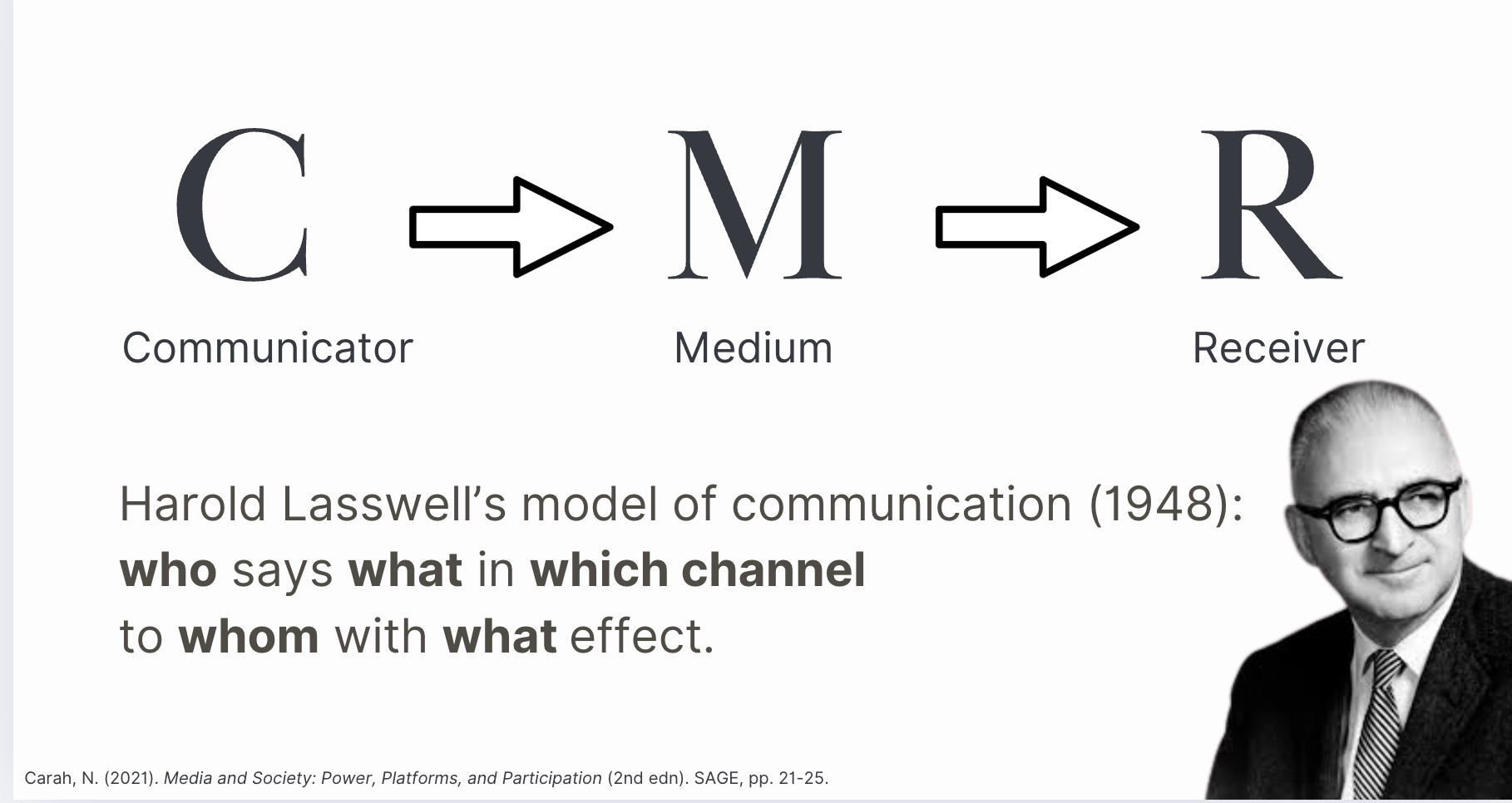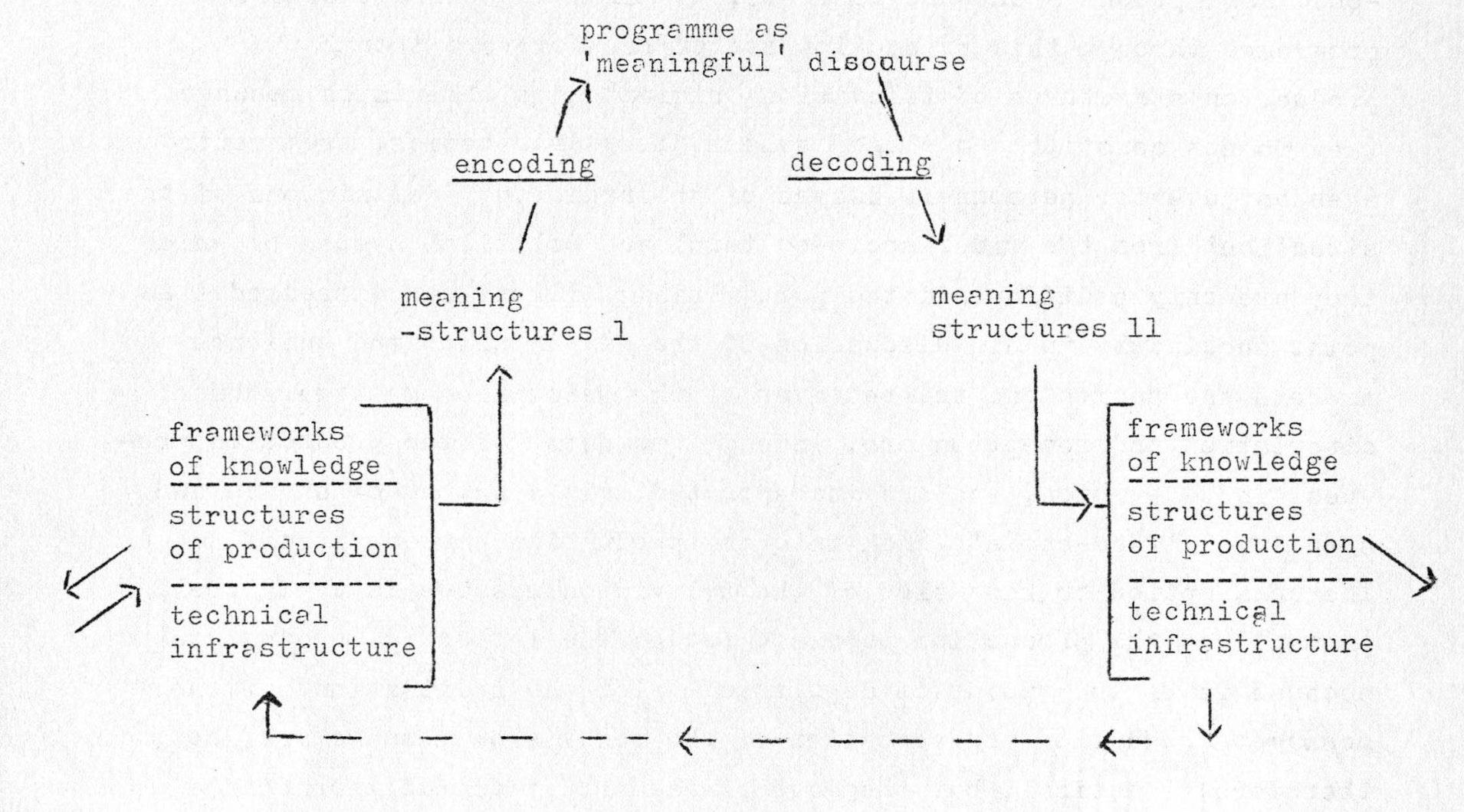COMU1120 - Media and Society
1/70
Earn XP
Description and Tags
Week 1 - 4
Name | Mastery | Learn | Test | Matching | Spaced |
|---|
No study sessions yet.
71 Terms
What does 'media' mean?
Individual: Our media are extensions of ourselves.
Social: Media are middle points between people.
Cultural: Media contribute to and create environments.
Who says 'The medium is the message'?
Marshall McLuhan
What does 'The medium is the message' mean?
The form of a medium has a more profound impact on society and human behavior than the specific content it carries.
How do the characteristics of a medium affect society?
The characteristics of the medium shape how we perceive, communicate, and organize our lives, often more significantly than the actual messages transmitted.
Week 2 Reading
Introduction in Media & society: power, platforms, & participation by Nicholas Cara
How is meaning made?
Meaning is created through social processes of encoding and decoding in institutional and social contexts, transferred via technology, and received or interpreted by audiences, shaping understanding of the world and social relationships.
How is power made and maintained?
Power is exercised through control over meaning, ideology, discourse, and hegemonic practices. It involves organizing social relationships and shaping perceptions to influence and manage populations.
What is ideology in media?
A framework of ideas that shapes decisions and actions, often constructed by powerful groups to reinforce their interests and influence societal beliefs.
What is a discourse
A system of meanings, ideas, and practices that inform societal rules and institutions, shaping perceptions of acceptable and unacceptable ways of life.
Define hegemony
The cultural condition where a particular way of life, ideas, and meanings are accepted as common sense and natural by the population, maintained by dominant groups.
What does today's cultural industry look like
It extends traditional mass media with digital media platforms that promote participatory content creation, collect data, and enable flexible, niche-marketed, and networked forms of capitalism, blending participation with data control.
How do platform media organize meaning making, participation, and data-processing?
They integrate participatory creation where audiences generate and circulate content, enable real-time interaction, and collect data for algorithms that personalize and control flows of information and attention.
What is the role of professional communicators in the exercise of power?
They manage meaning and participation, coordinate cultural and social narratives, monitor and respond to audiences in real time, and influence societal perceptions and power relations through strategic communication.
Describe the concept of interpretive resistance by audiences
The act of audiences reinterpreting or challenging mass-produced meanings to reflect their own identities or beliefs.
Describe media platforms as institutional forms of the culture industry
Digital environments that facilitate meaning-making, participation, and data collection, and are pivotal sites for organising social life.
Week 2 Reading ( n2)
Chapter 1: Meaning, Representation and Power in Media & society: power, platforms, & participation by Nicholas Carah
The term medium
The term 'medium' came into English usage in the twelfth century to describe 'something
which is intermediate' or 'between' two points (Oxford English Dictionary 2020). A medium
could be a thing, a substance, a relation, or even a person that sits in-between something.
An artist uses paint as a medium.
The two basic building blocks for an enquiry with a median?
Meaning: is the human capacity to use our bodies to communicate with each other. In meaning we get the cultural, social and symbolic dimension of human communication: the capacity to make, share and understand words, images and sounds.
Media: is the human capacity to create material structures, tools and institutions to collect, store, process and distribute information. We use media to organize our lived experience and to alter the world around us in durable ways
What are the two foundational qualities of media?
Media are both technical (tools for storing/distributing info) and cultural (symbols and stories that shape meaning).
Define "media" in a historical context.
Media are technologies and institutions that store, process, and circulate meaning; evolving from symbolic to technical to digital forms.
What is "meaning" in media studies?
The human capacity to make, share, and interpret symbols, images, and sounds to understand the world.
What are symbolic media?
Early forms like cave art and handwritten texts that required human perception and manual reproduction.
What are technical media?
Technologies like cameras and phonographs that store light/sound without human interpretation.
What are digital media?
Systems that convert all forms of information into binary code, enabling manipulation and customization.
What marked the shift to digital media?
The rise of the internet, smartphones, and platforms like Google, Facebook, and Netflix.
What are the four basic elements of communication models?
Communicator, Message, Medium, Receiver.
What does Lasswell's model emphasize?
The social and political effects of communication: "Who says what in which channel to whom with what effect."
What does Shannon's model emphasize?
The social and political effects of communication: "Who says what in which channel to whom with what effect."
The technical transmission of information: source → transmitter → channel → receiver → destination, with attention to noise.
What is hegemony?
The process by which dominant groups gain consent and legitimacy through meaning-making
How do elites maintain power?
Through access to media institutions, control of meaning, and use of professional communicators.
What are the three views on meaning?
Fixed (Saussure, Althusser): meaning is predetermined by structures.
Temporarily fixed (Foucault, Gramsci): meaning is mutable through struggle.
Always open (Derrida): meaning is endlessly shifting and remixable.
Lasswell's Model of Communication
A communication theory that describes the process of communication by identifying who says what, in which channel, to whom, and with what effect.
Element | Description |
|---|---|
Who | The communicator or sender |
Says What | The message being communicated |
In Which Channel | The medium used (e.g., TV, radio, social media) |
To Whom | The receiver or audience |
With What Effect | The impact or outcome of the communication |

Shannon’s Model of Communication
A mathematical model that describes how information is transmitted over a communication channel, focusing on the sender, message, channel, receiver, and noise.
Component | Description |
|---|---|
Information Source | Origin of the message |
Transmitter | Converts message into signal |
Channel | Medium through which signal travels |
Receiver | Converts signal back into message |
Destination | Final recipient of the message |
Noise Source | Any interference that distorts the signal |

Where does power come from?
There are three common explanations of the source of power:
access to material and cultural resources are needed to get your way and attain the consent of others. This includes the use or threat of violence
the occupation of social positions that enhance your capacity to get your way, have others comply with you and restrain the capacity of others to act
3. using and controlling meaning to structure social relations.
What is semiotics?
Semiotics is the study of signs and communication meaning. ( Texts are combinations of signs)
What does denotation mean?
literal meanings of the sign
What does connotation mean?
Associative meanings of signs
What does Intertextuality mean?
Reference to other texts
Sign = ?
Signifier + Signified

Week 4 Reading
The History of Communication
What distinction does Kittler make between communication and information systems?
Communication systems involve messages, people, and goods; information systems focus on storage, processing, and transmission of data.
What are the three operations in a communication system according to Kittler?
Data storage
Address transmission
Command processing
What are the five stages in Shannon’s model?
Information source
Transmitter
Channel
Receiver
Destination
What does Shannon’s model exclude?
Historical context and human meaning—it focuses purely on technical transmission.
What are the two main blocks in the history of media?
Writing (scripts and printing)
Technical media (telegraphy, analog, digital)
What is a codex and why is it significant in media history?
A codex is a book format with pages bound along one edge, replacing ancient scrolls. It revolutionized information storage by enabling easier navigation, indexing, and durability—laying the groundwork for mass printing and modern data systems.
What was the significance of the codex?
It allowed for indexing, durability, and easier reading—transforming how information was stored and accessed
How did Gutenberg’s printing press revolutionize media?
It standardized texts, enabled mass production, and laid the foundation for scientific and literary indexing.
What marked the shift from oral to technical media?
The invention of telegraphy, which decoupled communication from physical interaction.
What was the impact of Morse code?
It introduced binary-like efficiency and was the first step toward information technology.
What is the significance of Turing’s universal machine?
It formalized digital computation, enabling simulation of any algorithmic process.
What are the three components of von Neumann architecture?
Central processing unit
Memory (read/write and read-only)
Bus system for data transmission
How does digital media differ from analog?
It uses discrete binary data, allowing for precise manipulation and universal standardization.
What does Kittler argue about the end of media history?
It concludes when machines fully automate communication, potentially leading to artificial intelligence intercepting other intelligences.
What role does power play in media evolution?
Media technologies often emerge from military, political, and economic needs, shaping public and private communication.
Week 5 Reading
Encoding and decoding in the television discourse by Stuart Hall
What does the word ‘ code’ mean
A code is a system of signs and rules that allows meaning to be produced and understood. Its not just language - it includes visual imagery, gestures, sounds and cultural references.
Media and producers use to make sense of messages
What does Hall mean by “systematically distorted communication”?
Communication between media producers and audiences is shaped by unequal power relations, leading to misinterpretations or ideological bias.
What are the two key moments in the communication process according to Hall?
Encoding: The creation of a media message by producers using codes and conventions.
Decoding: The interpretation of that message by audiences, which may differ from the intended meaning.
What are the four components of Hall’s communication model?
Frameworks of knowledge
Relations of production
Technical infrastructure
Message as meaningful discourse

Why is the message-form “determinate”?
Because it shapes how the event is represented and understood—it must pass through language and codes to be communicated.
What is the dominant-hegemonic position?
When the audience decodes the message exactly as intended by the producer, accepting the dominant ideology.
What is the negotiated position?
When the audience partly accepts the dominant meaning but adapts it based on their own experiences or context.
What is the oppositional position?
When the audience understands the intended meaning but rejects it, interpreting the message through an alternative ideological lens.
How does Hall use the Western genre to illustrate encoding/decoding?
He shows how violence in Westerns is stylized and coded, often signifying deeper themes like masculinity or professionalism rather than literal aggression.
What does Hall say about polysemy in media texts?
Media signs are polysemic—they can carry multiple meanings depending on how they’re decoded.
What is the difference between denotation and connotation?
Denotation: Literal meaning of a sign.
Connotation: Cultural or ideological meaning layered onto the sign.
Why are connotative codes important in media?
They embed dominant ideologies and social norms into media messages, shaping how audiences interpret reality
What does Hall mean by “preferred readings”?
Interpretations that align with dominant cultural and ideological frameworks.
Why is “improving communication” not a neutral goal?
Because it often involves reinforcing dominant ideologies under the guise of clarity or education.
What role do professional media codes play?
They shape how messages are presented (e.g., visuals, editing) while subtly reproducing dominant meanings.